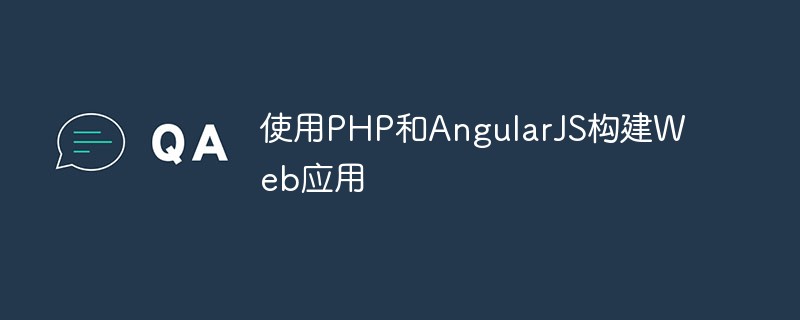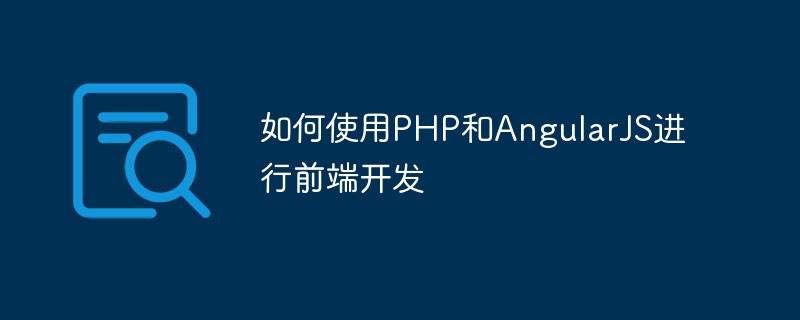Developers all agree that unit testing is very beneficial in development projects. They help you ensure the quality of your code, thereby ensuring more stable development and greater confidence even when refactoring is needed.

Test-driven development flow chart
AngularJS’s code claim of higher testability is indeed reasonable. Just the end-to-end test examples listed in the document can illustrate this. For projects like AngularJS, although unit testing is said to be easy, it is not easy to do it well. Even though the official documentation provides detailed examples, it is still very challenging in my actual application. Here I will simply demonstrate how I operate it.
Instant Karma
Karma is a test running framework developed by the Angular team for JavaScript. It easily automates testing tasks and replaces tedious manual operations (such as regression test sets or loading target test dependencies). The collaboration between Karma and Angular is like peanut butter and jelly.
You only need to define the configuration file in Karma to start it, and then it will automatically execute test cases in the expected test environment. You can specify the relevant test environment in the configuration file. angular-seed is a solution that I highly recommend and can be implemented quickly. The configuration of Karma in my recent project is as follows:
module.exports = function(config) {
config.set({
basePath: '../',
files: [
'app/lib/angular/angular.js',
'app/lib/angular/angular-*.js',
'app/js/**/*.js',
'test/lib/recaptcha/recaptcha_ajax.js',
'test/lib/angular/angular-mocks.js',
'test/unit/**/*.js'
],
exclude: [
'app/lib/angular/angular-loader.js',
'app/lib/angular/*.min.js',
'app/lib/angular/angular-scenario.js'
],
autoWatch: true,
frameworks: ['jasmine'],
browsers: ['PhantomJS'],
plugins: [
'karma-junit-reporter',
'karma-chrome-launcher',
'karma-firefox-launcher',
'karma-jasmine',
'karma-phantomjs-launcher'
],
junitReporter: {
outputFile: 'test_out/unit.xml',
suite: 'unit'
}
})
}
This is similar to the default configuration of angular-seed but has the following differences:
- It is necessary to change the browser from Chrome to PhantomJS, so that there is no need to open a new browser window every time you jump, but there will be a window delay in OSX system. So the plugin and browser settings have been changed.
- Because my application needs to reference Google’s Recaptcha service, I added the dependent recaptcha_ajax.js small file. This small configuration is as simple as adding a line of code to Karma's configuration file.
autoWatch is a really cool setting, it will let Karma automatically revert to your test cases when there are file changes. You can install Karma like this:
npm install karma
angular-seed provides a simple script inscripts/test.sh to trigger Karma tests.
Design test cases with Jasmine
Most resources are already available when designing unit test cases for Angular using Jasmine - a JavaScript testing framework with a behavior-driven development model.
This is what I want to talk about next.
If you want to unit test the AngularJS controller, you can use Angular's dependency injection dependency injection The function imports the service version required by the controller in the test scenario and also checks whether the expected results are correct. For example, I defined this controller to highlight the tab that needs to be navigated to:
app.controller('NavCtrl', function($scope, $location) {
$scope.isActive = function(route) {
return route === $location.path();
};
})
What would I do if I wanted to test the isActive method? I'll check if the $locationservice variable returns the expected value and the method returns the expected value. Therefore, in our test description, we will define local variables to save the controlled version required during the test and inject it into the corresponding controller when needed. Then in the actual test case we will add assertions to verify whether the actual results are correct. The whole process is as follows:
describe('NavCtrl', function() {
var $scope, $location, $rootScope, createController;
beforeEach(inject(function($injector) {
$location = $injector.get('$location');
$rootScope = $injector.get('$rootScope');
$scope = $rootScope.$new();
var $controller = $injector.get('$controller');
createController = function() {
return $controller('NavCtrl', {
'$scope': $scope
});
};
}));
it('should have a method to check if the path is active', function() {
var controller = createController();
$location.path('/about');
expect($location.path()).toBe('/about');
expect($scope.isActive('/about')).toBe(true);
expect($scope.isActive('/contact')).toBe(false);
});
});
Using the entire basic structure, you can design various types of tests. Since our test scenario uses the local environment to call the controller, you can also add some more attributes and then execute a method to clear these attributes, and then verify whether the attributes have been cleared.
$httpBackendIs Cool
So what if you are calling $httpservice to request or send data to the server? Fortunately, Angular provides a
Mock method of $httpBackend. In this way, you can customize the response content of the server, or ensure that the response results of the server are consistent with the expectations in the unit test.
The specific details are as follows:
describe('MainCtrl', function() {
var $scope, $rootScope, $httpBackend, $timeout, createController;
beforeEach(inject(function($injector) {
$timeout = $injector.get('$timeout');
$httpBackend = $injector.get('$httpBackend');
$rootScope = $injector.get('$rootScope');
$scope = $rootScope.$new();
var $controller = $injector.get('$controller');
createController = function() {
return $controller('MainCtrl', {
'$scope': $scope
});
};
}));
afterEach(function() {
$httpBackend.verifyNoOutstandingExpectation();
$httpBackend.verifyNoOutstandingRequest();
});
it('should run the Test to get the link data from the go backend', function() {
var controller = createController();
$scope.urlToScrape = 'success.com';
$httpBackend.expect('GET', '/slurp?urlToScrape=http:%2F%2Fsuccess.com')
.respond({
"success": true,
"links": ["http://www.google.com", "http://angularjs.org", "http://amazon.com"]
});
// have to use $apply to trigger the $digest which will
// take care of the HTTP request
$scope.$apply(function() {
$scope.runTest();
});
expect($scope.parseOriginalUrlStatus).toEqual('calling');
$httpBackend.flush();
expect($scope.retrievedUrls).toEqual(["http://www.google.com", "http://angularjs.org", "http://amazon.com"]);
expect($scope.parseOriginalUrlStatus).toEqual('waiting');
expect($scope.doneScrapingOriginalUrl).toEqual(true);
});
});
As you can see, beforeEach call is actually very similar. The only difference is that we get $httpBackend from the injector instead of getting it directly. Even so, there are some obvious differences when creating different tests. For starters, there will be an afterEachcall method to ensure that $httpBackend does not have obvious abnormal requests after each use case execution. If you look at the settings of the test scenario and the application of the $httpBackend method, you will find that there are a few things that are not so intuitive.
In fact, the method of calling $httpBackend is simple and clear, but it is not enough - we have to encapsulate the call into the $scope.runTest method in the actual test in the method of passing the value to $scope.$apply. This way the HTTP request can be processed only after $digest is triggered. As you can see, $httpBackend will not be parsed until we call the $httpBackend.flush() method, which ensures that we can verify whether the returned result is correct during the call (in the above example, the controller's The $scope.parseOriginalUrlStatusproperty property will be passed to the caller, so we can monitor it in real time)
The next few lines of code are assertions that detect the $scopethat attribute during the call. Cool right?
Tip: In some unit tests, users are accustomed to marking scopes without $ as variables. This is not mandatory or overemphasized in the Angular documentation, but I use $scopelike in order to improve readability and consistency.
Conclusion
Maybe this is one of those things that just comes naturally to me, but learning to write unit tests in Angular was definitely quite painful for me at first. I found that much of my understanding of how to get started came from a patchwork of various blog posts and resources on the internet, with no really consistent or clear best practices, but rather through random choices that came naturally. I wanted to provide some documentation of what I ended up with to help others who may be struggling because they just want to write code rather than having to understand all the weird and unique features of Angular and Jasmine. usage. So I hope this article can be of some help to you.
 2022年最新5款的angularjs教程从入门到精通Jun 15, 2017 pm 05:50 PM
2022年最新5款的angularjs教程从入门到精通Jun 15, 2017 pm 05:50 PMJavascript 是一个非常有个性的语言. 无论是从代码的组织, 还是代码的编程范式, 还是面向对象理论都独具一格. 而很早就在争论的Javascript 是不是面向对象语言这个问题, 显然已有答案. 但是, 即使 Javascript 叱咤风云二十年, 如果想要看懂 jQuery, Angularjs, 甚至是 React 等流行框架, 观看《黑马云课堂JavaScript 高级框架设计视频教程》就对了。
 使用PHP和AngularJS搭建一个响应式网站,提供优质的用户体验Jun 27, 2023 pm 07:37 PM
使用PHP和AngularJS搭建一个响应式网站,提供优质的用户体验Jun 27, 2023 pm 07:37 PM在如今信息时代,网站已经成为人们获取信息和交流的重要工具。一个响应式的网站能够适应各种设备,为用户提供优质的体验,成为了现代网站开发的热点。本篇文章将介绍如何使用PHP和AngularJS搭建一个响应式网站,从而提供优质的用户体验。PHP介绍PHP是一种开源的服务器端编程语言,非常适用于Web开发。PHP具有很多优点,如易于学习、跨平台、丰富的工具库、开发效
 使用PHP和AngularJS构建Web应用May 27, 2023 pm 08:10 PM
使用PHP和AngularJS构建Web应用May 27, 2023 pm 08:10 PM随着互联网的不断发展,Web应用已成为企业信息化建设的重要组成部分,也是现代化工作的必要手段。为了使Web应用能够便于开发、维护和扩展,开发人员需要选择适合自己开发需求的技术框架和编程语言。PHP和AngularJS是两种非常流行的Web开发技术,它们分别是服务器端和客户端的解决方案,通过结合使用可以大大提高Web应用的开发效率和使用体验。PHP的优势PHP
 使用PHP和AngularJS开发一个在线文件管理平台,方便文件管理Jun 27, 2023 pm 01:34 PM
使用PHP和AngularJS开发一个在线文件管理平台,方便文件管理Jun 27, 2023 pm 01:34 PM随着互联网的普及,越来越多的人在使用网络进行文件传输和共享。然而,由于各种原因,使用传统的FTP等方式进行文件管理无法满足现代用户的需求。因此,建立一个易用、高效、安全的在线文件管理平台已成为了一种趋势。本文介绍的在线文件管理平台,基于PHP和AngularJS,能够方便地进行文件上传、下载、编辑、删除等操作,并且提供了一系列强大的功能,例如文件共享、搜索、
 如何使用PHP和AngularJS进行前端开发May 11, 2023 pm 05:18 PM
如何使用PHP和AngularJS进行前端开发May 11, 2023 pm 05:18 PM随着互联网的普及和发展,前端开发已变得越来越重要。作为前端开发人员,我们需要了解并掌握各种开发工具和技术。其中,PHP和AngularJS是两种非常有用和流行的工具。在本文中,我们将介绍如何使用这两种工具进行前端开发。一、PHP介绍PHP是一种流行的开源服务器端脚本语言,它适用于Web开发,可以在Web服务器和各种操作系统上运行。PHP的优点是简单、快速、便
 如何在PHP编程中使用AngularJS?Jun 12, 2023 am 09:40 AM
如何在PHP编程中使用AngularJS?Jun 12, 2023 am 09:40 AM随着Web应用程序的普及,前端框架AngularJS变得越来越受欢迎。AngularJS是一个由Google开发的JavaScript框架,它可以帮助你构建具有动态Web应用程序功能的Web应用程序。另一方面,对于后端编程,PHP是非常受欢迎的编程语言。如果您正在使用PHP进行服务器端编程,那么结合AngularJS使用PHP将可以为您的网站带来更多的动态效
 使用Flask和AngularJS构建单页Web应用程序Jun 17, 2023 am 08:49 AM
使用Flask和AngularJS构建单页Web应用程序Jun 17, 2023 am 08:49 AM随着Web技术的飞速发展,单页Web应用程序(SinglePageApplication,SPA)已经成为一种越来越流行的Web应用程序模型。相比于传统的多页Web应用程序,SPA的最大优势在于用户感受更加流畅,同时服务器端的计算压力也大幅减少。在本文中,我们将介绍如何使用Flask和AngularJS构建一个简单的SPA。Flask是一款轻量级的Py


Hot AI Tools

Undresser.AI Undress
AI-powered app for creating realistic nude photos

AI Clothes Remover
Online AI tool for removing clothes from photos.

Undress AI Tool
Undress images for free

Clothoff.io
AI clothes remover

AI Hentai Generator
Generate AI Hentai for free.

Hot Article

Hot Tools

Safe Exam Browser
Safe Exam Browser is a secure browser environment for taking online exams securely. This software turns any computer into a secure workstation. It controls access to any utility and prevents students from using unauthorized resources.

SublimeText3 Mac version
God-level code editing software (SublimeText3)

Atom editor mac version download
The most popular open source editor

PhpStorm Mac version
The latest (2018.2.1) professional PHP integrated development tool

VSCode Windows 64-bit Download
A free and powerful IDE editor launched by Microsoft







